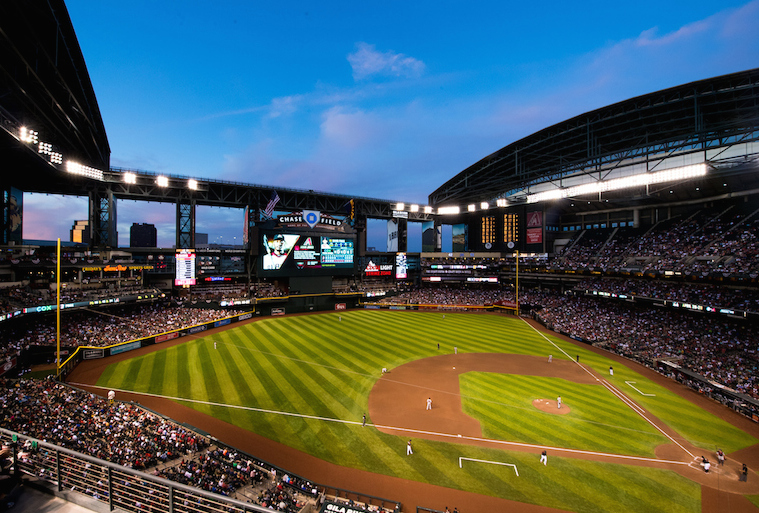Since Opening Day at Chase Field this season, the Arizona Diamondbacks have played on their new surface, specifically designed for baseball. The “Batting a Thousand” (B1K) turf is a dual fiber system comprised of Shaw Sports Turf Strenex XD slit film and Shaw’s Bolt monofilament, which is designed to prevent infill “splash out.” The Geofill infill is made from natural materials, says Shaw.
The Diamondbacks expected reduced energy costs by keeping the roof closed during daytime as well as saving money from using less water on the field.
We asked Arizona Diamondbacks President and CEO Derrick Hall some questions about how the new surface is performing.
SportsTurf: Has the new surface met your expectations so far this season?
Hall: Our new synthetic grass has far exceeded our expectations. The feedback we continue to receive is that the surface has only improved with more and more usage and the initial feedback was extremely positive. In addition to the high performing playing surface, we’ve seen an enormous improvement in the comfort of Chase Field. Our fan experience is very important to us and now with our ability to keep the roof closed during road trips and extended breaks, it has kept the ballpark cleaner and much more comfortable for fans. We played games with our roof open through June this season, where we use to only get through May due to extreme heat permeating off the concrete and our previous inability to close the roof in a timely manner. Our environmental impact is also very important to us and with the addition of synthetic grass, we are able to not only conserve our cooling energy but are expected to save nearly 2 million gallons (a 90% savings) in water consumption each season.
ST: What have the players and coaches said about the new surface?
Hall: The feedback from players and coaches from both the D-backs and visiting teams has been tremendous. We played the Red Sox to open the season and since they play at least 18 games a year on other synthetic fields, they came in with a pretty good perspective on synthetic fields. The feedback we received from their coaching staff and several position players was that our new field was an excellent field, not because it was natural or synthetic, simply that it played true and consistently throughout the series. We’ve also received feedback from teams within our division that their mid-season trips to Chase Field are much more enjoyable because of the consistency of our surface. They would complain that our natural field was almost like playing in two different ballparks (when comparing the conditions in April vs. July). Our team, the reigning Wilson Defensive Team of the Year, has been very happy with the new surface.
ST: What is the general maintenance routine, e.g., how often do you groom it, how are you keeping infill level, etc.?
Hall: Our grounds crew keeps quite busy ensuring the field is the best possible playing surface. During the home stand, they mat drag pretty much every other day. After the home stand they run a UV light cart over the field three times and groom. They are constantly hand picking/sweeping/vacuuming/washing/utilizing a spring tine rake/power brooming turf edges to keep warning track and infield material out of turf, regardless if the team is at home or on the road. They also use a custom made 7.5-foot-wide GreensGroomer to level the infill and just started to spot topdress areas using a Stihl Yard Boss broom to work Geofill infill material in.
ST: Have there been any problems and if so, how were they resolved?
Hall: No problems but simply a learning curve. The Geofill infill does require some water, so understanding the right timing and frequency to keep moisture on the field has been something we have constantly tweaked as weather conditions have changed. For our groundskeepers to be able to work with a closed roof most of the time has been an enormous improvement in workplace conditions when temperatures consistently exceed 110 degrees daily during the majority of our season.
ST: The iconic dirt stripe from the mound to home plate didn’t make the switch though originally it was slated to. What happened?
Hall: It was simply a decision we made to remove the feature as we replaced the field. We felt that a continuous infield surface would be simpler to maintain and present a more aesthetically appealing look with the new field.


